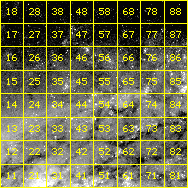

Of course, you cannot possibly discern by eye the specific intensity variations which characterize Cepheids. Sophisticated computer programs were required to do that. You will simply look for variable stars, and click on a suspected Cepheid. If the star is a Cepheid, you will be rewarded with information on the star. If not, the hunt continues!
The hunt will take place only in chip 4 (WF4) of the M100 images. WF4 has been divided into an 8x8 numbered grid for the purpose:


In the real Cepheid hunt, clicking on a grid section with a number will begin a hunt in that section. (Clicking on the above images will have no effect.) The WF4 image without the grid is mapped in the same way as the image with the grid; clicking on the same location in either image will produce the same result. The best way to see how all this works is to walk through the process step by step the first time. Some grid sections contain Cepheids, while others do not. You will be told how many known Cepheids are in each grid section.
Make sure you have a printed copy of the lab sheet before beginning this demonstration.
Let's first look at the case where there are no known Cepheids.
Case 1: Grid section contains no known Cepheids
If the grid section does not contain any known Cepheids, you can
explore the images, or return to the main 8x8 grid to choose another
grid section. Record the grid section number in Part I, Section A of
your lab sheet to prevent you from repeating work unnecessarily.
Just because there are no Cepheids in the grid section certainly doesn't mean there is nothing of interest in the images! If an object intrigues you, you may want to inquire about it. Before you can ask your teaching assistant or professor about the object, you will need some means of accurately conveying the object's position. You will see how to do that in this demo.
In this demonstration, the usual text for the Cepheid hunt will be in normal type. The added demonstration text will be in red type. The blinked images you viewed in the last section (Classifying variable phenomena on HST images) were of grid section 26. Click on grid section 26 in the image below to see a typical Web page for a grid section containing no known Cepheids:

Grid section 47 contains more Cepheids than any other section, and they are fairly easy to discern. Please follow the demonstration step by step. The usual text for the Cepheid hunt will be in normal type. The added demonstration text will be in red type.
Click on grid section 47 below to begin the demonstration.

Notes:
Back to Classifying variable phenomena on HST images
Back to the table of contents